For quilters, the fabric is our canvas. It’s the foundation upon which breathtaking colors, intricate patterns, and cherished memories come together. But with a vast array of quilting fabrics available, choosing the right material can feel overwhelming. Fear not, fellow stitchers!
This comprehensive guide will delve into types of quilting fabric materials, empowering you to select the perfect match for your next project.
Cotton Quilting Fabric
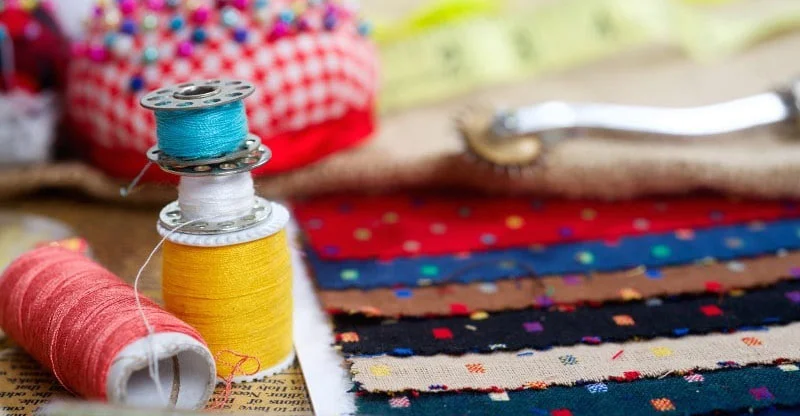
Cotton quilting fabric is the most popular choice for quilters, and for good reason! Here’s a breakdown of its key features and why it’s such a beloved material:
The Champion for a Reason:
- Breathability: Cotton’s natural fibers allow air to circulate, making it comfortable to use in quilts year-round, especially in warmer climates.
- Easy Care: Machine washable in most cases, cotton is generally low maintenance. Pre-washing your cotton fabric is recommended to remove sizing or shrinkage.
- Versatility: Cotton offers a vast array of colors, patterns, and weights to suit any project. From crisp prints for piecing to soft solids for backgrounds, the creative possibilities are endless.
Types of Cotton Quilting Fabric:
- Quilting Weight Cotton: This is the industry standard, with a width of around 44-45 inches. It offers a perfect balance between drape and structure, making it easy to handle and sew with. It’s ideal for most quilting projects.
- Broadcloth: Similar to quilting weight cotton, broadcloth boasts a smooth, even weave. It’s often used for piecing quilt blocks or creating borders due to its ability to create crisp lines.
Additional Considerations:
- Thread Count: Refers to the number of threads per square inch. A higher thread count indicates a denser weave, resulting in a smoother and potentially more durable fabric. However, for most quilting projects, a medium thread count (around 180) offers a good balance between affordability and quality.
- Colorfastness: Ensure the fabric won’t bleed or fade during washing. Look for fabrics labeled “colorfast” or pre-wash your fabric before using it in your quilt.
Cotton Quilting Fabric: The Perfect Starting Point
Cotton quilting fabric is an excellent choice for beginner and seasoned quilters alike. Its versatility, ease of use, and wide availability make it a perfect starting point for your quilting adventures. As you gain experience, you can explore other materials and specialty fabrics to create unique and stunning quilts.
Batik Quilting Fabric
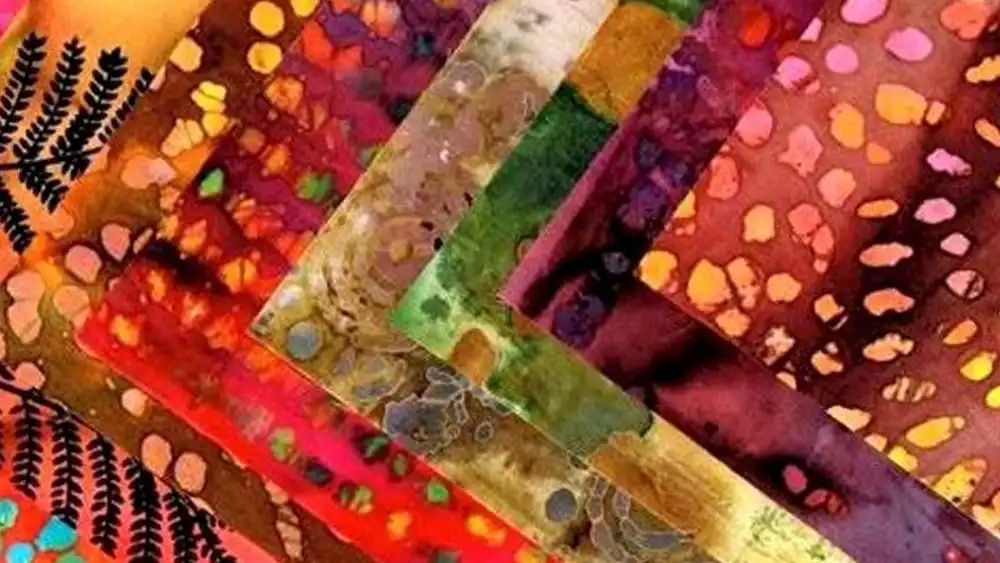
Batik fabric is a unique and beautiful option for quilters, offering a vibrant and artistic twist to your projects. Here’s a closer look at its characteristics:
Creation Process:
- Batik fabric is created using a wax-resist dyeing technique. Artisans apply molten wax to specific areas of the fabric, preventing dye from penetrating those areas.
- The fabric is then submerged in one or more dye baths, creating vibrant and often multicolored patterns.
- Once dyed, the wax is removed, revealing the intricate resist patterns and creating the characteristic “crackled” look of batik fabric.
Properties of Batik Fabric:
- Unique Aesthetics: Batik fabrics boast a stunning array of colors and patterns, from geometric designs to floral motifs and everything in between. No two pieces of true batik fabric are exactly alike, adding a one-of-a-kind element to your quilt.
- Lightweight to Medium Weight: Batik fabrics typically fall in the lightweight to medium weight category, making them ideal for piecing quilt tops, wall hangings, or even clothing.
- Consideration: Due to the wax resist process, batik fabrics can have a slightly uneven surface texture. This adds to the unique character but might require some adaptation in your sewing technique.
Choosing Batik Fabrics for Quilting:
- Color Palette: Batik fabrics come in a vast array of colors. Consider the overall theme of your quilt and choose batiks that complement your chosen color scheme.
- Pattern Scale: Batik fabrics come in various pattern scales, from small and intricate motifs to large, bold designs. Select a scale that suits your project’s style. Batiks with smaller patterns can be effectively used for piecing, while larger, bolder prints might be better suited as accent pieces.
- Pre-washing: It’s recommended to pre-wash your batik fabric before using it in your quilt. This helps remove any residual wax and ensures the colors won’t bleed during the washing process.
Incorporating Batik Fabric into Your Quilts:
- Piecing: Use batik fabrics as part of your pieced quilt blocks, adding vibrant pops of color and unique patterns.
- Borders: Batik fabrics can create stunning borders for your quilt, framing your pieced top beautifully.
- Applique: The unique designs of batik fabrics lend themselves perfectly to applique techniques, allowing you to create stunning focal points or embellishments.
With its captivating beauty and versatility, batik fabric can elevate your quilts to a whole new level of artistic expression. So, next time you’re looking for a way to add a touch of the extraordinary to your project, consider the magic of batik fabric!
Woven Quilting Fabric
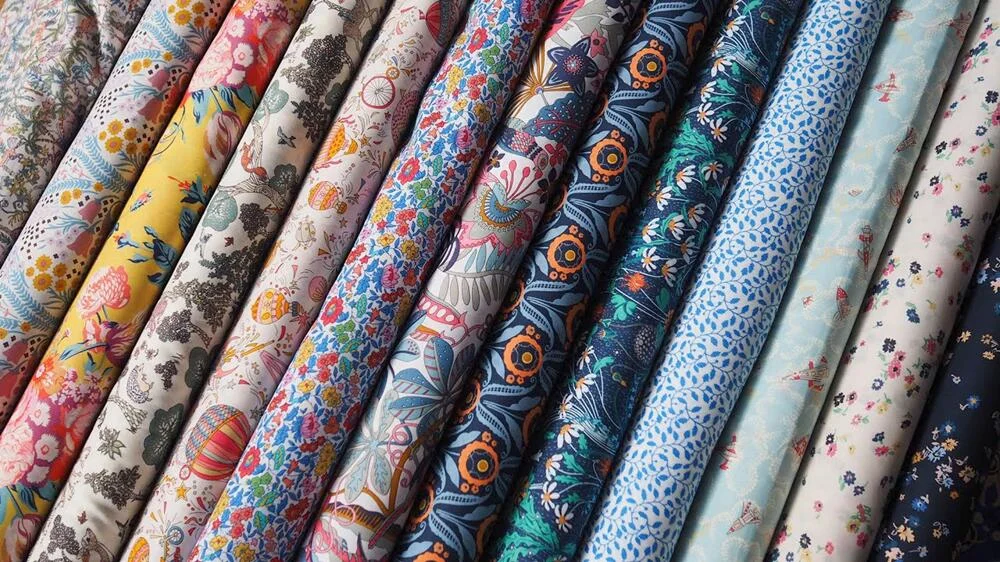
Woven quilting fabric is the most common type of fabric used for quilting. It refers to the way the threads are interlaced to create the material. Here’s a breakdown of woven quilting fabric and why it’s so popular:
The Weaving Process:
- Woven fabrics are constructed by interlacing perpendicular sets of threads: the warp threads (lengthwise) and the weft threads (crosswise). This creates a stable and strong material that holds its shape well.
Why Woven Fabrics are Ideal for Quilting:
- Stability: The woven structure provides stability and prevents the fabric from stretching or distorting, crucial for precise piecing and maintaining crisp lines in your quilt design.
- Drape: Depending on the weight and fiber content, woven fabrics can offer a variety of drape options. Quilting weight cotton, for example, offers a good balance between drape and structure, allowing for both piecing and creating quilts with some flow.
- Versatility: Woven fabrics come in a vast array of colors, patterns, and textures, catering to any quilter’s style and project needs. From classic solids and florals to modern geometrics and batiks, the possibilities are endless.
Types of Woven Quilting Fabrics:
- Quilting Weight Cotton: This is the industry standard for quilting due to its perfect balance of weight, drape, and ease of sewing.
- Broadcloth: Similar to quilting weight cotton, broadcloth offers a smooth, even weave, ideal for piecing quilt blocks or creating borders.
- Linen: While not as common as cotton, linen adds a touch of luxury and durability to quilts. Keep in mind its tendency to wrinkle more easily.
- Silk: For a truly luxurious quilt, consider silk, but be prepared for delicate handling and special care requirements.
Additional Considerations:
- Thread Count: A higher thread count indicates a denser weave, resulting in a smoother and potentially more durable fabric. However, for most quilting projects, a medium thread count (around 180) offers a good balance between affordability and quality.
- Colorfastness: Ensure the fabric won’t bleed or fade during washing. Look for fabrics labeled “colorfast” or pre-wash your fabric before using it in your quilt.
By choosing woven quilting fabrics, you’ll set yourself up for quilting success. Their stability, versatility, and wide range of options make them the perfect foundation for creating beautiful and long-lasting quilts.
Flannel Quilting Fabric
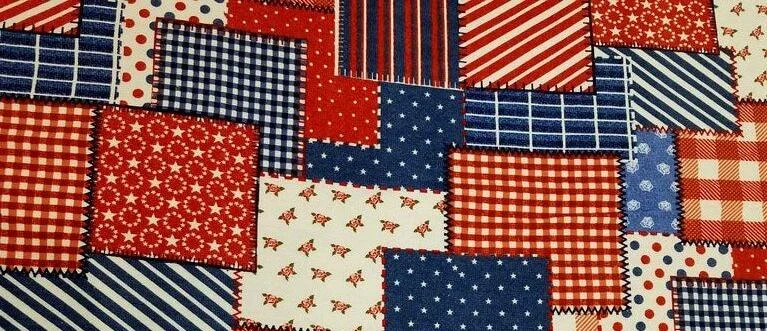
Flannel fabric is a cozy and inviting choice for quilters seeking to create warm and cuddly projects. Here’s a breakdown of its key characteristics and quilting applications:
Texture and Warmth:
- Flannel is renowned for its delightfully soft and fuzzy texture, achieved through a brushing process that raises the fabric’s nap.
- This soft nap traps air, creating a layer of insulation that makes flannel quilts perfect for keeping you warm and snug on chilly nights.
Material and Weight:
- Flannel is typically made from 100% cotton, although cotton blends can sometimes be found.
- Flannel quilting fabric falls in the lightweight to medium weight category, making it ideal for:
- Quilt backs: Flannel creates a luxuriously soft backing for your quilt, perfect for cuddling under.
- Throws: Flannel throws are ideal for adding a touch of warmth and comfort to any living space.
- Baby quilts: The softness of flannel makes it a popular choice for creating cozy and cuddly quilts for little ones.
Design Considerations:
- Flannel comes in a variety of colors and patterns, from classic plaids and checks to playful prints and even solids.
- Consider the overall theme of your quilt when choosing flannel fabrics.
- For a truly luxurious touch, flannel can be paired with other warm and inviting fabrics like fleece or minky fabric.
Sewing with Flannel:
- Flannel’s soft nap can present some challenges when sewing. Here are some tips for success:
- Use a sharp needle to prevent snags.
- Increase your stitch length slightly to prevent puckering.
- Consider using walking feet on your sewing machine to ensure even feeding of the fabric.
- Pre-wash your flannel fabric to remove any sizing or shrinkage before sewing.
Flannel: The Perfect Choice for Cozy Quilts
Flannel’s combination of softness, warmth, and versatility makes it a favorite among quilters seeking to create comfortable and inviting projects. From cuddly baby quilts to luxurious throws, flannel adds a touch of cozy charm to any quilt. So, the next time you’re looking to create a quilt that sparks warmth and comfort, consider the delightful embrace of flannel fabric.
Linen Quilting Fabric
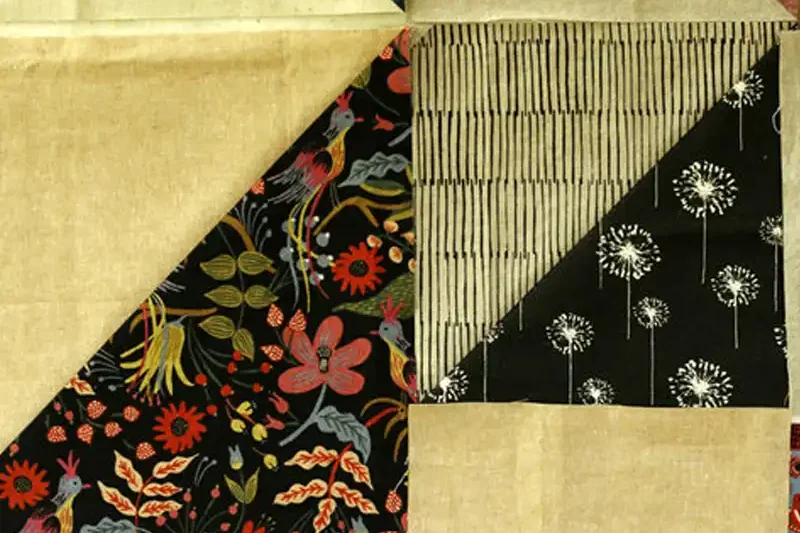
Linen quilting fabric offers a touch of elegance and durability to your quilts. Here’s a breakdown of its characteristics to help you decide if it’s the perfect fit for your project:
Allure of Linen:
- Luxurious Drape: Linen’s natural fibers drape beautifully, creating flowy and visually striking quilts. This makes it ideal for wall hangings, throws, or even elegant bedspreads.
- Natural Strength: Renowned for its durability, linen is a great choice for heirloom quilts that can be passed down through generations. With proper care, linen quilts can become treasured family possessions.
Considerations for Linen:
- Wrinkles: Unlike cotton, linen wrinkles more easily. While some quilters embrace the natural crinkled look, if you prefer a smoother finish, you might need to iron your linen fabric more often.
- Care: Linen requires special handling compared to cotton. It’s recommended to dry clean linen quilts or hand wash them in cool water with gentle detergents.
- Sewing Challenge: Linen’s stiffer texture compared to cotton can present a slight challenge for beginners. Using sharp needles and adjusting sewing machine tension might be necessary.
Using Linen Quilting Fabric Effectively:
- Blending: Linen can be beautifully blended with cotton fabrics. Use it for quilt backs or borders to add a touch of luxury and visual interest to your cotton quilt top.
- Piecing: While possible, piecing with linen requires more care due to its stiffer nature. Consider using larger linen pieces or piecing techniques specifically designed for linen fabrics.
- Applique: Linen’s firm texture makes it a great choice for applique. The raw edges of linen applique can add a rustic charm to your quilt.
Linen’s Not Your Only Option:
- Linen Blends: Fabrics that blend linen with cotton offer a good compromise. You get some of the luxurious drape of linen with the easier care and sewing characteristics of cotton.
Linen’s Final Thread:
Linen quilting fabric adds a touch of sophistication and timeless beauty to your projects. While it requires a bit more TLC than cotton, the reward is a stunning and heirloom-quality quilt. If you’re a beginner quilter, consider starting with cotton or cotton blends and graduate to linen as your skills progress.
Minky Quilting Fabric
Minky fabric, also known as cuddle fabric, is a popular choice for quilters seeking a luxuriously soft and cuddly element in their projects. Here’s a breakdown of its key characteristics and considerations for quilting:
Pros of Minky Fabric:
- Unmatched Softness: Minky fabric boasts an incredibly soft and plush texture, perfect for creating cuddly throws, baby quilts, or snuggle blankets.
- Variety of Colors and Prints: Minky fabric comes in a wide range of solid colors and playful prints, allowing you to incorporate it into quilts with various themes.
- Visually Appealing: The soft sheen and plush texture of minky fabric add a visually appealing dimension to your quilts.
Cons of Minky Fabric:
- Sewing Challenges: The thick and fluffy texture of minky fabric can be challenging to sew with, especially for beginners. Special sewing techniques and needles might be required to achieve a neat finish.
- Bulk Factor: Due to its thickness, minky fabric can add significant bulk to your quilt. Consider using it in smaller quantities or for specific sections of your quilt, like the backing or a cuddly border.
- Warmth: While the coziness is a plus for some projects, the warmth of minky fabric might not be ideal for all climates or quilt uses.
Using Minky Fabric in Quilting:
- Quilt Backing: Minky fabric is a popular choice for quilt backings, creating a luxuriously soft and cuddly layer to snuggle under.
- Borders: Consider using minky fabric for narrow borders, adding a touch of softness without overwhelming the overall design.
- Applique: The soft texture of minky fabric can be used for applique accents on your quilt top, adding a playful or decorative element.
- Binding: Minky fabric binding can be a challenge due to its thickness. If you choose to use it for binding, consider special techniques or alternative binding options.
Tips for Sewing with Minky Fabric:
- Walking Foot: A walking foot helps prevent the fabric from feeding unevenly while sewing.
- Sharp Needles: Use sharp needles specifically designed for synthetic fabrics to avoid snags or tears.
- Longer Stitch Length: A slightly longer stitch length (around 3mm) can help prevent the fabric from bunching up.
- Practice: Before diving into your main project, practice sewing with minky fabric scraps to get comfortable with the techniques.
Alternatives to Minky Fabric:
If the sewing challenges of minky fabric are a concern, consider these alternatives:
- Flannel: Offers a soft and cozy texture, perfect for quilt backings or throws.
- Fleece: Similar to minky but with a slightly less plush texture, making it easier to sew with.
- Cuddle Doodles: A specific brand of minky fabric known for being slightly thinner and easier to sew with compared to traditional minky fabrics.
By understanding the unique properties and considerations of minky fabric, you can incorporate this luxurious material into your quilting projects for added softness, texture, and visual appeal.
Rayon Quilting Fabric
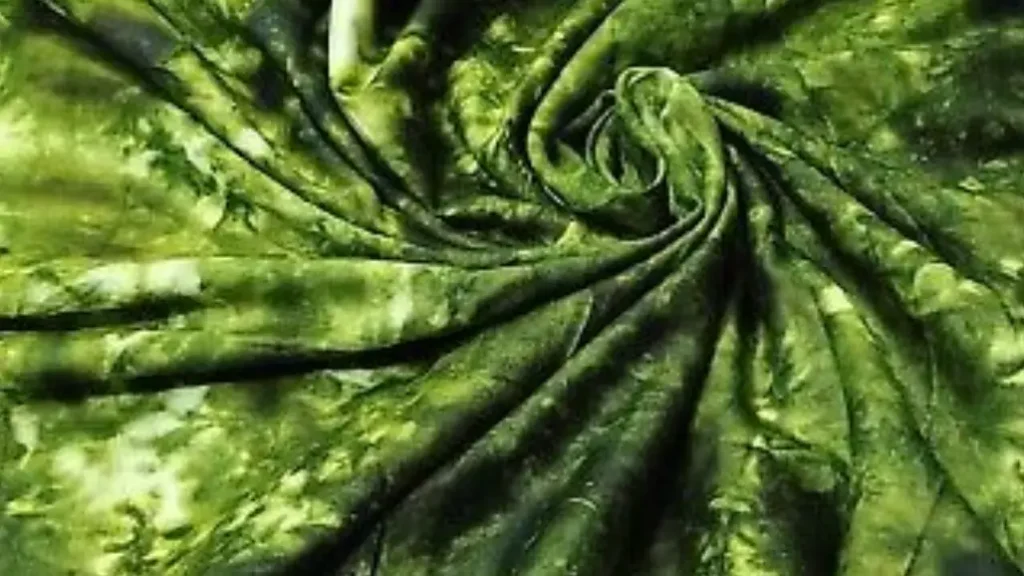
Rayon fabric can be a wonderful addition to your quilting toolbox, offering a luxurious feel and vibrant colors. Here’s a breakdown of its characteristics to help you decide if it’s the perfect fit for your next project:
Allure of Rayon:
- Silky Texture: Rayon boasts a smooth, soft feel similar to silk, adding a touch of elegance and drape to your quilts.
- Vibrant Colors: Rayon dyes exceptionally well, resulting in rich, saturated colors that will stay bright for years to come. This makes it ideal for creating quilts with bold and eye-catching color palettes.
- Lightweight to Medium Weight: Rayon fabrics typically fall in the lightweight to medium weight category. This makes them perfect for:
- Quilt Backings: A lightweight rayon creates a soft and comfortable backing for your quilt.
- Summer Quilts: The lighter weight allows for breathability, making it ideal for warmer weather quilts.
- Clothing: Rayon can also be used for creating light and flowy garments.
Considerations for Quilting with Rayon:
- Drape: Rayon’s drape can be a double-edged sword. While it adds a luxurious look, it can also be slightly slippery to sew with, especially for beginners. Using pins liberally and sewing with a walking foot can help ensure smooth seams.
- Washing Care: Rayon requires special care compared to cotton. Always pre-wash your rayon fabric to avoid shrinkage. Rayon is generally hand-wash or delicate cycle friendly, and ironing should be done on a low setting.
Tips for Using Rayon in Quilting:
- Pre-washing: As mentioned earlier, pre-washing rayon fabric is crucial to prevent shrinkage.
- Starching: Lightly starching your rayon fabric before cutting and sewing can help make it easier to handle and prevent slipping.
- Sharp Scissors: Use sharp rotary cutters or fabric scissors to ensure clean cuts that won’t fray easily.
- Walking Foot: Using a walking foot on your sewing machine can help prevent the fabric from slipping while feeding it evenly.
Creative Applications of Rayon in Quilting:
- Blended with Cotton: Consider using rayon fabrics blended with cotton. These blends can offer the beautiful drape of rayon with the easier handling characteristics of cotton.
- Piecing: While rayon can be used for piecing, its slippery nature might be challenging for beginners. Pre-washing and starching can help, or you can reserve rayon for piecing larger blocks.
- Accents and Borders: Rayon fabrics shine as stunning accent pieces or borders for your quilt. Their vibrant colors and drape can add a touch of elegance and visual interest.
- Applique: The smooth texture of rayon makes it well-suited for applique techniques. You can create beautiful appliqued designs to add a unique touch to your quilt.
Rayon fabric offers a unique combination of beauty and practicality for quilting. By understanding its characteristics and using the right techniques, you can incorporate rayon into your projects to create stunning and luxurious quilts.
Canvas Quilting Fabric

Canvas fabric can be a great choice for specific quilting applications, offering durability and a unique aesthetic. Here’s a breakdown of canvas quilting fabric:
Properties of Canvas:
- Durability: Canvas is a heavyweight fabric known for its strength and resilience. This makes it ideal for quilts that will see frequent use or washing, like throws, bags incorporated into quilts, or even outdoor quilts.
- Texture: Canvas has a slightly stiff and textured feel compared to traditional quilting cotton. This can add a unique visual element to your quilt but might require some adjustments in your sewing technique.
- Variety: Canvas comes in a variety of colors, from natural tones to vibrant hues. You can also find canvas with printed designs, although these might be less common than solid colors.
Applications of Canvas Quilting Fabric:
- Accents and Bags: Canvas is a great choice for creating sturdy pockets, bags, or even tote bags that can be incorporated into your quilt design.
- Artful Quilts: The unique texture and durability of canvas can be perfect for creating art quilts or modern quilts with a focus on texture and dimension.
- Floor Quilts: Due to its durability, canvas can be a suitable choice for floor quilts that will see a lot of wear and tear.
Things to Consider When Using Canvas for Quilting:
- Needle Selection: A heavier needle designed for upholstery or canvas fabrics might be necessary to pierce the thicker fibers effectively.
- Sewing Machine: Your sewing machine should be able to handle the weight and texture of canvas fabric. Consider trying a scrap of canvas on your machine before committing to a larger project.
- Quilting Techniques: Some quilting techniques, like intricate piecing, might be more challenging with canvas due to its stiffness. However, applique or simple piecing can work well with this fabric.
Alternatives to Canvas Quilting Fabric:
- Duck Cloth: Similar to canvas in weight and texture, duck cloth offers another option for a durable quilting fabric. It might be slightly lighter and more flexible than canvas.
- Heavyweight Cotton: Look for quilting weight cottons with a higher thread count for a more durable option that is still easier to sew with compared to canvas.
Overall, canvas quilting fabric offers a unique combination of durability and aesthetics. While it might require some adjustments in your sewing approach, it can be a great choice for specific quilting projects where sturdiness and a touch of artistic texture are desired.
Conclusion
The world of quilting fabrics is a treasure trove waiting to be explored. From the timeless comfort of cotton to the artistic flair of batiks, each material offers a unique story waiting to be woven into your quilt. With the knowledge you’ve gleaned from this guide, you’re now empowered to:
- Select the perfect fabrics for your next project, considering weight, drape, texture, and care requirements.
- Embrace experimentation! Don’t be afraid to mix and match different materials to create one-of-a-kind masterpieces.
- Build a well-stocked fabric stash that reflects your personal style and inspires endless creative possibilities.
Remember, quilting is a journey, and the fabric you choose is your first step on that path. So, let your imagination be your guide, embrace the magic of quilting materials, and get ready to stitch your story into every beautiful piece you create!
Call to Action:
- Ready to put your fabric knowledge to the test? Share a picture of your latest quilt project and the fabrics you used in the comments below!
- Do you have a favorite quilting fabric? We’d love to hear about it! Share your thoughts and experiences in the comments section.
- Happy quilting! May your fabric choices forever inspire you and may your quilts become cherished heirlooms for generations to come.
